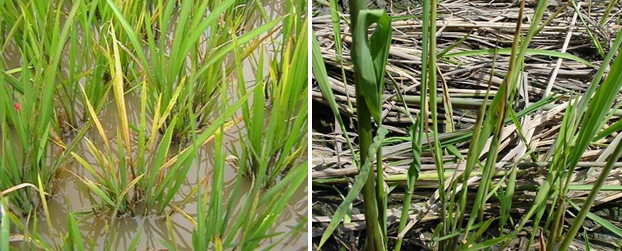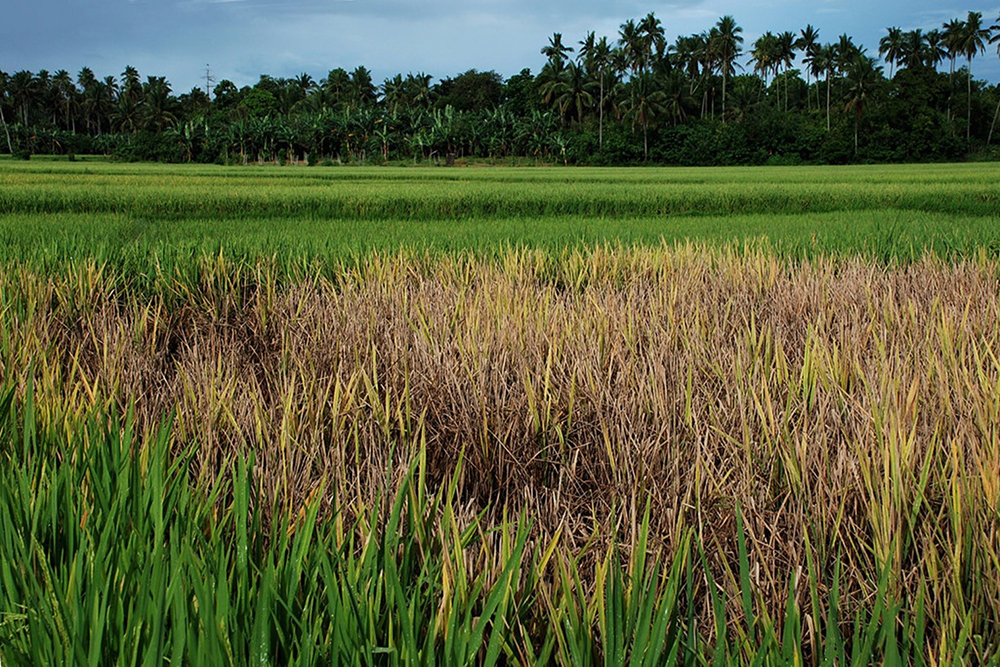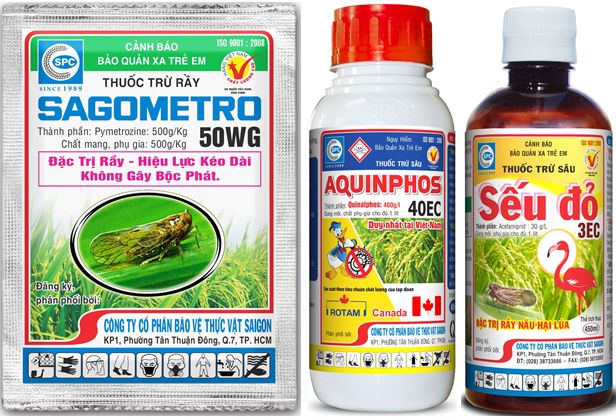|
Brown plant hopper - hazards and prevention measures
08/12/2021
MSc Huynh Kim Ngoc Brown plant hoppers cause damage by sucking rice sap, transmitting viral diseases. Hoppers can cause damage from the sowing stage to the time of harvest. The field gets hopper burned in clusters, where the rice grows well, densely or near where there is light at night. hoppers live and cause damage mainly at the base of rice. Hoppers lay eggs in sheaths and veins, have 5 age levels , 2-3 days molt once, life cycle is about 28-30 days, adult hoppers like lamp light, there are 2 forms: Short wings and long wings, full fields enough food, short-winged hoppers dominate, when the field runs out of food or unfavorable weather conditions, the hoppers will migrate (at night).
In addition to damage caused by hoppers burnt, hoppers also transmit yellow dwarf virus, leaf curl dwarf and weedy rice. The disease has no cure. Young hoppers and adult ones both have the ability to transmit viruses, molting hoppers still transmit the disease, however, the disease is not transmitted through eggs. The incubation period in hoppers is about 7-10 days virus infected hoppers eat rice less than 1 hour. can transmit disease to healthy rice, one individual brown plant hopper can transmit both yellow dwarf and leaf curl dwarf disease at the same time, on the same rice bush can carry both yellow dwarf and leaf curl dwarf disease. However, in the same bush, there can be diseased and non-diseased tillers. The incubation period in rice depends on the variety and the stage of infection.
In general, the earlier the infection stage (about 1 month after sowing - rice with short days), the shorter the incubation period and the more severe the damage..Echinochloa sp (rice weed), Leptochloa chinensis is an intermediate host of the disease, the disease is not transmitted through hoppers eggs, seeds, soil, water, wind, wounds on rice...
Integrated measures to manage brown plant hoppers and viral diseases in rice: (1) Limit planting infected varieties, (2) Sowing at the same time (avoiding plan hoppers) according to the instructions of the authorities, (3) No.thick sowing,transplanting, (4) Sanitize the field, do not leave ratoon rice, (5) Release ducks to eat hoppers (if conditions allow), (6) Raise the water level in the field to kill the eggs (if possible), (7) The most frequent field visit is at the beginning of one month after sowing, (8) Pay attention to kill hoppers in the seedling stage, (9) Regularly monitor pest announcements on mass media, (10) Spraying specific products according to the instructions of the Plant Protection Department such as Butyl (Buprofezin) 10WP, 400SC, Bascide (Fenobucarb) 50EC, Schezgold (Pymetrozin) 500WG, Brimgold (Dinotefuran + Imidaclopride) 200WP or Sairifos (Chlorpyrifos + Cypermethrin) 585EC ( In case the density of hoppers is too high, it is necessary to immediately suppress the epidemic). Attention should be sprayed according to 4- correct rule, sprayed with the recommended amount of pesticidal water (minimum 2 tanks of 16 liters/1000 m2), sprayed on the root where the hoppers live and cause harm, can be sprayed early in the morning or in the cool late afternoon
|
To prevent, in addition to plowing and burying weed seeds, collecting weed stalks and stumps left after tilling the land to burn, not letting weeds produce seeds in production fields, etc., the use of chemical products is still a measure. optimal because of its ability to thoroughly kill weeds, reduce labor and take advantage of more time than manual weeding.
Miner has the scientific name Phyllocnistis citrella Staint., family Phyllocnistidae, order Lepidoptera. The miner occurs in many countries in the tropics and subtropics. The main host of the miner is the citrus family - Rutaceae. In addition, the miner also attacks mangosteen and some other plants.
Adult is a small planthopper, with a body 2-3 mm long, the whole body is ash gray, slightly greenish, the wings are opaque with many small brown spots.Eggs are oval, 0.3 mm long, have a pointed end and are attached directly to the leaf surface, leaf axils.
Green bugs specialize in the fruit of citrus groups (oranges, tangerines, lemons, grapefruits, kumquats...), some people call them orange bugs, or orange suckers. Their scientific name is Rhynchocoris poseidon or Rhynchocoris humeralis.
In Vietnam, yellow leaf curl disease is very common on papaya trees, especially the disease is often severe in areas of high and continuous planting, areas with hot and arid climates. The disease has significantly reduced the yield and quality of papaya. Gardens that are infected early when the plants are young may not yield. However, up to now, many gardeners still do not know the cause and how to fix it.
Spider mites are common pests on citrus trees, especially in hot and dry climates that are suitable for spiders to grow and cause severe damage.The group of harmful spiders is usually very small in size, unlike the natural enemy spiders.
This group includes species that are generally very small in size, causing damage by sucking plant sap (on leaves, fruits, branches, stems).
There are many species of mealybugs present on the group of Oranges,Tangerines,Grapefruits and Lemons (Citrus), which can be divided into 2 groups:
+ Group of sticky mealybugs with common varieties such as Lepidosaphes, Aonidiella, Coccus and Saissetia.
+ Group of flower mealybugs with common genera and species such as Pseudococcus, Planococcus and Icerya purchasi.
Dry branches and berries disease often appear to be common damage on coffee gardens during the rainy season. The disease causes death of branchs, dry fruit, severely affects the canopy structure and coffee yield if not paid attention to prevention.
Pink disease commonly causes diseases on rubber plantations in the rainy season, especially on garden from 4-8 years old. This year, rubber has to go through a period of severe drought, weakening the tree, so now in tnshe rainy season it is easy to get infected. Therefore, it is necessary to pay attention to good management to avoid affecting the garden.
In recent years, the area of citrus has been expanded because it is a fruit tree with high economic efficiency. However, in order to sell at a high price, not only in quality but consumers also require the external beauty of the fruit, so pest management on citrus is a matter of great concern to farmers. The hot season is a favorable condition for thrips to develop and cause damage, affecting the commercial value of fruit.
- Headquarters
- SAIGON PLANT PROTECTION JOINT STOCK COMPANY
- RQ 1, Nguyen Van Quy St., Tan Thuan Ward, HCM City
- Tax code: 0300632232
- Tel: (028) 38 733 295 - 38 732 077
- Fax: (028) 38 733 003 - 38 733 391
- Website: www.spchcmc.vn - Email: info@spchcmc.vn
- SAIGON PLANT PROTECTION COMPANY
- SAIGON PLANT PROTECTION JOINT STOCK ENTERPRISE
- Lot C1-C3 Hiep Phuoc Industrial Park, Hiep Phuoc Commune, HCM City
- Tel: (028) 3873 4089 - Fax: (028) 3873 4086
- Affiliated Unit
-
- Quick Links
- Home
- About us
- Career Opportunities















